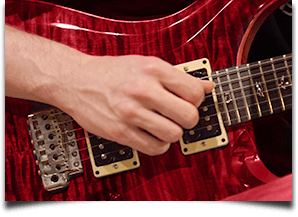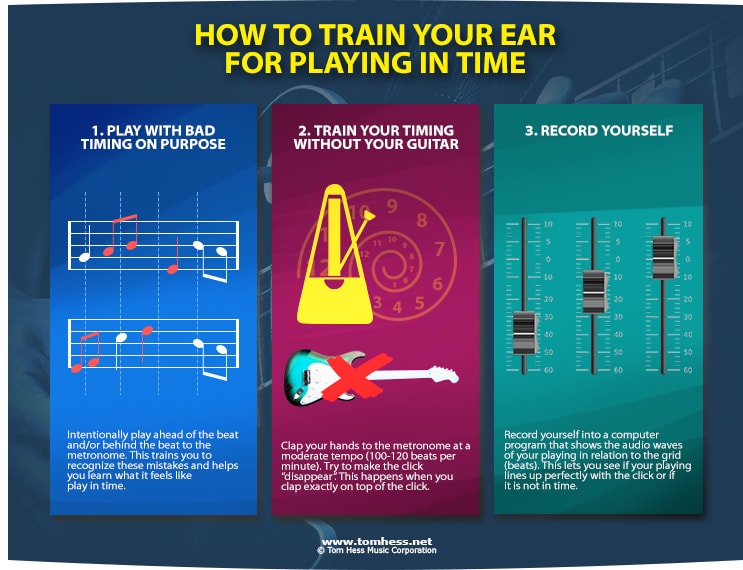How To Get Tight Rhythm Guitar Playing Like A Pro
By Tom Hess
Hearing Rhythm Guitar Flaws

By submitting your info, you agree to send it to Tom Hess Music Corporation who will process and use it according to their privacy policy.
Tight rhythm guitar playing is about training your ear to focus on the right things when you practice. This allows you to identify sloppy rhythm guitar playing mistakes and fix them.
Check out this video to learn how to fix a very common rhythm guitar flaw that could be impacting your playing right now:
Answer: Playing in time is only one aspect of rhythm guitar mastery. There are MANY other elements of tight rhythm playing that practicing with a metronome cannot help you master. More importantly, “playing to a metronome” does not automatically improve your timing. Metronome practice only works when you know what to listen for and what mistakes to avoid (more on this below).
Question: “Tom Hess, how does training one’s ear improve one’s rhythm guitar playing? Isn’t ear training about identifying intervals, chords and scales?”
Answer: Ear training consists of many things. Training your ear to identify chords, scales and intervals is one aspect of ear training. Identifying rhythms (note values) by ear is another. Identifying rhythm guitar playing flaws is a third area of ear training. (There are other elements of ear training that are specific to lead guitar. They include: telling good vibrato apart from bad vibrato, hearing consonance and dissonance and identifying chord functions in a chord progression.)
Hearing Rhythm Guitar Flaws

By submitting your info, you agree to send it to Tom Hess Music Corporation who will process and use it according to their privacy policy.

Rhythm Guitar Playing Mistake Category #1: Palm Muting Flaws
Mistake #1: Palm Muting Everything You Play
Palm muting everything makes it hard to emphasize important notes or chords in your rhythm guitar riffs.
The purpose of muting some notes and not others is to create a contrast between muted and unmuted notes (and chords). The contrast makes the unmuted notes emphasized. The other reason to mute notes is for the percussive sound and tighter control over the strings when playing.Question: “Tom Hess, do I always need to plan out which notes or chords to mute and which ones to not mute?”
Answer: Yes, if you want your rhythm playing to sound as good as possible. You MUST plan out your palm muting in guitar riffs you intend to record. This is key to recording tight guitar parts like a pro. This also helps you record your music quickly and saves you A LOT of money in studio costs.
That said, planning out which notes to palm mute is not hard. You quickly learn to feel which notes and chords need muting and which ones don't.Mistake #2: Inconsistent Palm Muting
There are 2 types of inconsistent palm muting:
- Type 1: Randomly changing which notes are muted. Listen to an example. You first hear a rhythm guitar riff played with consistent muting, followed by the same riff played with inconsistent muting.




- The first recording of the riff (0:00-0:09) follows the palm muting pattern shown in the tab. The second version of the riff (0:10 - 0:19) has inconsistencies in measures 2, 3 and 4. Sometimes the chords are muted where they shouldn’t be and other times the chords are NOT muted where they should be. The fill in measure 4 is played with (sloppy) palm muting instead of being played unmuted.
- Type 2: Randomly varying the intensity of your palm muting. Listen to an example. You first hear a power chord played with consistent muting, followed by the same power chord played with inconsistent palm muting. Sometimes the muting is just right, sometimes it is too weak and other times it is very aggressive.
Both versions of inconsistent palm muting tend to occur together.
Note: Randomly inconsistent palm muting is NOT the same as intentionally varying your palm muting. The former is a result of sloppy guitar playing. The latter is done on purpose to create rhythm guitar variations.
Mistake #3: Exaggerated (Aggressive) Palm Muting
Aggressive palm muting is caused by pressing too hard on the strings with the palm. It is also caused by placing the palm too far away from the bridge (closer to the fretboard). This makes palm muting sounds exaggerated. Your pick strokes sound like percussive thuds instead of actual notes (or strums).
Exaggerated palm muting develops from taking palm muting for granted and never really listening to your own playing.
How To Fix Sloppy Palm Muting:
Record yourself often and listen back with your full attention. Ask yourself: “What might I change about my palm muting to make this riff sound better?” Then implement your corrections in your next guitar practice session.
Tip: Listen back to your playing using headphones. This helps you concentrate better and hear your playing more clearly.
Mastering palm muting also makes it easy to articulate the notes clearly in your rhythm guitar riffs. Balancing the right amount of palm muting with playing some notes unmuted makes your riffs sounds tight, clean and pro.
Question: “Tom Hess, can one really tell the difference between randomly inconsistent palm muting and palm muting that is varied on purpose? Isn’t it a matter of one’s opinion?”
Answer: Inconsistent palm muting is very easy to spot. It leaves behind many clues, such as:
- Inconsistent palm muting often falls on awkward places within the riff. Example: muting the downbeat and playing the rest of the riff unmuted.
- Inconsistent palm muting is often accompanied by sloppy string noise and weak articulation (and other mistakes described below).
An expert guitar teacher can analyze your rhythm guitar playing and give you honest feedback on its tightness.
 How To Play Awesome Guitar Riffs
How To Play Awesome Guitar RiffsFind out how to play killer rhythm
guitar riffs in a rock/metal style.
 Become A Killer Rhythm Guitarist
Become A Killer Rhythm GuitaristStart playing killer heavy metal rhythm guitar using these 5 tips.
 Learn What To Practice On Guitar
Learn What To Practice On GuitarLearn how to become a balanced
guitarist and fix your weaknesses.
Rhythm Guitar Playing Mistakes Category #2: Timing Flaws
Many guitarists assume that practicing with a metronome automatically trains one to play in time. False! Your timing only improves when you:
- Hear the difference between playing ahead of the beat, behind the beat and on the beat. This tells you how close you are to playing in time.
- Have specific practice strategies to correct your timing problems. Your mind must be focused like a laser on training you to play in time.
A metronome is only useful after your mind (and ears) know what to focus on and how to focus on it. Without this awareness, metronome practice becomes mindless. Mindless practicing is a complete waste of your time.
Common rhythm guitar timing flaws include:- Playing ahead of the beat. This means your notes are displaced and occur before the metronome or drum beat.
- Playing behind the beat. This means your notes are displaced and occur after the metronome or drum beat.
- Playing all over the place - this means your timing is inconsistent. Some of your guitar playing is ahead of the beat and some of it is behind the beat.
The goal is to play on the beat. This means your notes and chords fall exactly on top of the metronome or drum beat.
Listen to an audio example of rhythm guitar played in time.
Listen to an audio example of rhythm guitar played ahead of the beat.
Listen to an audio example of rhythm guitar played behind the beat.
Double tracking rhythm guitar parts is the ultimate test of playing in time. Both tracks must be in time with the beat and with each other. When you can consistently double track tight rhythm guitar parts, you have mastered this element of rhythm guitar playing.Taking rhythm guitar lessons helps you master perfect timing a lot faster.
As your ears improve, test your rhythm guitar playing to track your progress.Rhythm Guitar Playing Mistakes Category #3: Picking Articulation Flaws
Good picking articulation makes it easy to hear each note (or chord) in your guitar riffs. Poor picking articulation makes it hard to hear what notes are played.
Watch this video to hear the difference between good and bad rhythm guitar articulation and learn how to make your guitar playing sound great:
Poor rhythm guitar articulation develops from:
Weak Pick Attack - this means picking the notes too lightly when you play rhythm guitar.Inconsistent Pick Attack - this means hitting some notes loudly and others softly. This imbalance makes it hard to articulate the notes clearly.
Sloppy 2-Hand Synchronization - this means your hands are picking, fretting and releasing a note at different times. The faster you play, the more obvious 2-hand synchronization problems become. This makes it much harder to articulate the notes clearly.
2-hand synchronization problems are caused by sloppy guitar technique and poor practice habits. This eGuide shows how to improve your lead guitar technique and play guitar fast.Action Steps To Improve Your Rhythm Guitar Playing:
- Record your rhythm guitar playing regularly and analyze your recordings. This trains your ear to identify weaknesses that hold your guitar playing back.
- Make a list of specific problems you want to fix. This helps you avoid overwhelm and tells you what to do next to improve your guitar playing.
- Focus on the problems you want to fix. You can do this in 2 ways:
- Focus on one problem in isolation until it is fixed. This tactic is best for short-term problems that can be solved quickly.
Or
- Rotate your focus among several problems in the same practice session. Example: repeat a guitar riff for 30 seconds focusing on palm muting. Then play it for 30 seconds focusing on playing in time. Next, focus on your picking articulation for 30 seconds. Rotate through this mini circuit over and over for 10-15 minutes. This tactic works best for long-term development.
- Get feedback on your guitar playing from an expert guitar teacher to track your progress and become a better rhythm guitarist a lot faster.
 About Tom Hess: Tom Hess is a guitar teacher, music career mentor and guitar teacher trainer. He teaches rock guitar lessons online to students from all over the world and conducts instructional live guitar training events attended by musicians from over 50 countries.
About Tom Hess: Tom Hess is a guitar teacher, music career mentor and guitar teacher trainer. He teaches rock guitar lessons online to students from all over the world and conducts instructional live guitar training events attended by musicians from over 50 countries.
Study the best rock and metal guitar lessons online.


